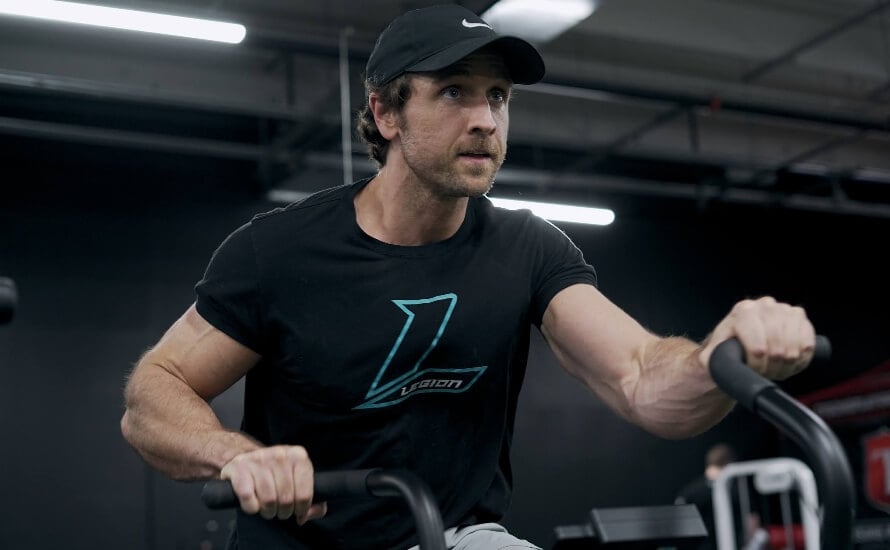Most people think bulking and cardio don’t mix.
Cardio burns calories, and bulking is all about eating more and gaining weight—so why bother?
But skipping cardio while bulking could be holding you back. When done right, cardio can actually enhance your strength training performance, speed up recovery, and improve your overall health—benefits that can help you gain more mass in the long run.
In this article, we’ll explore why cardio belongs in your bulking plan, how it benefits your performance, and how to do it without sacrificing gains.
Key Takeaways
- Cardio while bulking improves your weightlifting performance by enhancing recovery between sets and helping you lift more with less fatigue.
- Including cardio during a bulk helps you maintain cardiovascular fitness, which can make it easier to transition to a cutting regimen that involves several cardio sessions each week.
- Regular cardio supports overall health by lowering blood pressure, improving cholesterol levels, and enhancing metabolic and mental well-being.
- To reap the benefits without drawbacks, keep cardio to 2-to-3 sessions per week, prioritize low-impact activities, and keep each session under 40 minutes.
Should You Do Cardio While Bulking?

Yes, most people benefit from doing cardio while bulking in four ways:
- It improves your strength training performance.
- It boosts your recovery between sets.
- It keeps you in the habit.
- It optimizes your health.
Let’s explore these in detail.
Doing Cardio Enhances Strength Training Performance
Many weightlifters think strength training is purely anaerobic—it only involves short bursts of intense effort that don’t require oxygen to create energy.
In reality, your aerobic system (which produces energy using oxygen during prolonged exercise) plays a bigger role than most realize.
For example, during a 200-meter sprint (about 20 seconds), around one-third of the energy comes from the aerobic system. For longer sprints—like 400 or 800 meters—over half the energy comes from aerobic sources.
The same applies to weightlifting: a heavy set of five reps relies on aerobic energy for about 30% of the effort, and higher-rep sets rely on it even more—more than 50% in some cases.
Why does this matter?
A stronger aerobic system lets you do more reps before you fatigue. It also makes lifting the same weight feel easier because you rely less on anaerobic energy, which tires you out faster.
You may also depend more on aerobic energy as your workout progresses.
Early in a session, your anaerobic system provides most of the energy. But as you tire, the aerobic system takes over, handling the majority of the workload.
For most gymgoers, this means your aerobic system plays a key role in keeping you going to the end of a tiring training session. The stronger it is, the better you’ll perform at the back end of a workout.
RELATED: How to Improve Your VO2 Max Fast
Doing Cardio Boosts Recovery Between Sets
When you’re lifting heavy weights, your anaerobic system takes the lead to produce quick bursts of energy.
But between sets, your aerobic system steps in to clean up the mess: It restores energy reserves (like ATP and PCr), clears waste products like lactate, and brings your body back to baseline so you can hit the next set hard. The better your aerobic conditioning, the faster and more efficiently this process happens.
As you get stronger, this becomes even more crucial.
Research shows that deadlifting 385 pounds for a set of 8 burns about 25 calories. Double the weight to 770 pounds, and you’re burning 50 calories for the same set. That’s twice the energy demand in the same time frame—largely supplied by anaerobic systems.
For beginners lifting relatively light weights, this isn’t a big issue. But as the weights increase, the energy demands soar, and your recovery between sets can become a bottleneck. That is, without solid aerobic conditioning, you might find your progress stalling simply because you can’t recover fast enough.
RELATED: How Long Should You Rest Between Sets to Gain Muscle and Strength?
Doing Cardio While Bulking Keeps You in the Habit
A common pitfall for bodybuilders is losing cardiovascular fitness after months of focusing solely on heavy strength training.
When they finally reintroduce cardio—often while cutting—it’s an uphill battle. Jumping from no cardio to multiple sessions a week while eating in a calorie deficit puts significant strain on the body. This extra stress can make fat loss harder, both physically and mentally, and may even accelerate muscle loss.
The solution?
Continue doing cardio while bulking.
Doing so helps maintain your cardiovascular fitness and avoids the shock to your system when you start cutting. You’ll also likely see smoother fat loss—people who keep up regular cardio tend to retain the ability to burn fat more efficiently, even after long periods bulking.
Cardio Optimizes You Health
Cardio offers many health benefits that you can’t get from weightlifting alone, such as lower blood pressure, reduced cholesterol levels, and better blood vessel function.
It also enhances metabolic health, sharpens cognitive function, and boosts overall well-being.
3 Ways Cardio While Bulking Can Hinder Progress

While cardio has many benefits, it can also hinder your efforts to bulk in three main ways:
- Reducing your caloric surplus too much: Regular cardio sessions don’t burn enough calories to be a concern (a few hundred at most). However, long or intense sessions can create a deficit that’s harder to make up for—especially for “hardgainers” who already struggle to eat enough.
- Overtraining: Too much intense cardio can overload your body, slow recovery, and hurt your performance in weightlifting workouts. Over time, this can hinder your ability to build muscle.
- Time Investment: You don’t need hours of training to build solid cardiovascular conditioning, but it still takes time—something not everyone can spare.
Fortunately, you can easily counter these drawbacks with proper workout programming.
How Much Cardio Should You Do When Bulking?
The downsides of cardio during bulking almost always come from doing too much. To enjoy the benefits without the drawbacks, you need to carefully control how much you’re doing.
Here are some simple guidelines to keep things on track:
- Do 2-to-3 low- to moderate-intensity sessions per week, lasting 20-to-40 minutes each.
- Add one HIIT workout per week if you enjoy it (optional).
- Cap your total cardio at 2-to-3 hours per week.
- Do cardio and weightlifting on different days. If that’s not possible, lift weights first and leave at least 6 hours between sessions.
RELATED: Concurrent Training: The Right Way to Combine Cardio and Strength Training
FAQ #1: Can I run while on a bulk?
Yes, but you should limit how much running you do each week, as it’s typically more fatiguing than a lower-impact form of cardio like cycling, rowing, or rucking.
Start with two low- to moderate-intensity runs lasting 20-to-40 minutes each. From there, adjust based on how your body responds: increase the frequency or duration if you recover and perform well, or scale back if running hampers your weight training.
RELATED: The Complete Guide on How to Start Running
FAQ #2: Do bodybuilders do cardio while bulking?
It depends on the individual and their goals, but many bodybuilders include cardio during bulking.
How much cardio do bodybuilders do?
Again, it largely depends on the athlete, but most shoot for around 2-to-3 low-intensity cardio sessions each week, each lasting around 30 minutes.
FAQ #3: Is cardio bad for bulking?
No, cardio isn’t bad for bulking, provided you don’t overdo it. In fact, doing cardio while bulking offers several benefits.
Specifically, it helps improve your weightlifting performance, boosts between-set recovery, may make it easier to lose fat again once you begin cutting, and keeps you in good mental and physical health.
Scientific References +
- Mr, Spencer, and Gastin Pb. “Energy System Contribution during 200- to 1500-m Running in Highly Trained Athletes.” Medicine and Science in Sports and Exercise, 1 Jan. 2001, pubmed.ncbi.nlm.nih.gov/11194103/.
- Brown, Stanley P., et al. “Prediction of the Oxygen Cost of the Deadlift Exercise.” Journal of Sports Sciences, vol. 12, no. 4, Aug. 1994, pp. 371–375, https://doi.org/10.1080/02640419408732183. Accessed 11 Aug. 2020.
- ESCAMILLA, RAFAEL F., et al. “A Three-Dimensional Biomechanical Analysis of Sumo and Conventional Style Deadlifts.” Medicine & Science in Sports & Exercise, vol. 32, no. 7, July 2000, pp. 1265–1275, https://doi.org/10.1097/00005768-200007000-00013.
- Brillon, D. J., et al. “Effect of Cortisol on Energy Expenditure and Amino Acid Metabolism in Humans.” American Journal of Physiology-Endocrinology and Metabolism, vol. 268, no. 3, 1 Mar. 1995, pp. E501–E513, https://doi.org/10.1152/ajpendo.1995.268.3.e501. Accessed 13 May 2022.
- Melanson, Edward L., et al. “Exercise Improves Fat Metabolism in Muscle but Does Not Increase 24-h Fat Oxidation.” Exercise and Sport Sciences Reviews, vol. 37, no. 2, Apr. 2009, pp. 93–101, https://doi.org/10.1097/jes.0b013e31819c2f0b. Accessed 19 Nov. 2019.
- Carpio-Rivera, Elizabeth, et al. “Acute Effects of Exercise on Blood Pressure: A Meta-Analytic Investigation.” Arquivos Brasileiros de Cardiologia, vol. 106, no. 5, 2016, https://doi.org/10.5935/abc.20160064.
- Mann, Steven, et al. “Differential Effects of Aerobic Exercise, Resistance Training and Combined Exercise Modalities on Cholesterol and the Lipid Profile: Review, Synthesis and Recommendations.” Sports Medicine, vol. 44, no. 2, 31 Oct. 2013, pp. 211–221, www.ncbi.nlm.nih.gov/pmc/articles/PMC3906547/, https://doi.org/10.1007/s40279-013-0110-5.
- Cocks, Matthew, et al. “Sprint Interval and Endurance Training Are Equally Effective in Increasing Muscle Microvascular Density and ENOS Content in Sedentary Males.” The Journal of Physiology, vol. 591, no. 3, 31 Jan. 2013, pp. 641–656, https://doi.org/10.1113/jphysiol.2012.239566. Accessed 8 Nov. 2019.
- Church, Timothy S, et al. “Effects of Aerobic and Resistance Training on Hemoglobin A1c Levels in Patients with Type 2 Diabetes: A Randomized Controlled Trial.” JAMA, vol. 304, no. 20, 24 Nov. 2010, pp. 2253–62, https://doi.org/10.1001/jama.2010.1710.
- Chapman, Sandra B., et al. “Shorter Term Aerobic Exercise Improves Brain, Cognition, and Cardiovascular Fitness in Aging.” Frontiers in Aging Neuroscience, vol. 5, 2013, https://doi.org/10.3389/fnagi.2013.00075.
- Mousavi Gilani, Seyed Reza, and Abdurrashid Khazaei Feizabad. “The Effects of Aerobic Exercise Training on Mental Health and Self-Esteem of Type 2 Diabetes Mellitus Patients.” Health Psychology Research, vol. 7, no. 1, 11 Mar. 2019, www.ncbi.nlm.nih.gov/pmc/articles/PMC6441819/, https://doi.org/10.4081/hpr.2019.6576.
- Broskey, Nicholas T., et al. “Effect of Aerobic Exercise-Induced Weight Loss on the Components of Daily Energy Expenditure.” Medicine & Science in Sports & Exercise, vol. 53, no. 10, 1 Oct. 2021, pp. 2164–2172, journals.lww.com/acsm-msse/Fulltext/2021/10000/Effect_of_Aerobic_Exercise_induced_Weight_Loss_on.15.aspx?context=FeaturedArticles&collectionId=1, https://doi.org/10.1249/MSS.0000000000002689. Accessed 30 Sept. 2021.
- Millet, Guillaume Y, and Romuald Lepers. “Alterations of Neuromuscular Function after Prolonged Running, Cycling and Skiing Exercises.” Sports Medicine, vol. 34, no. 2, 2004, pp. 105–116, https://doi.org/10.2165/00007256-200434020-00004.










